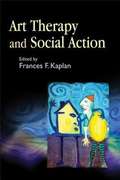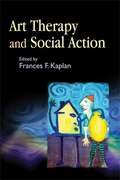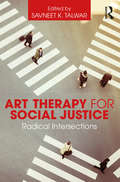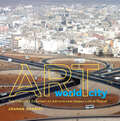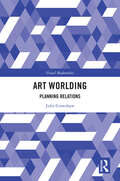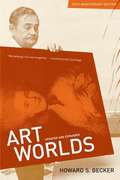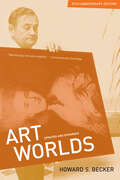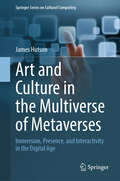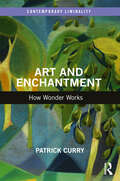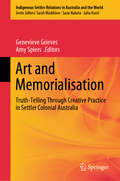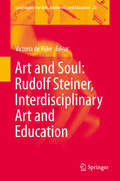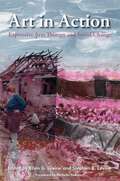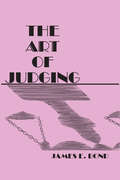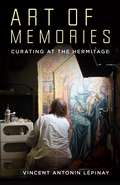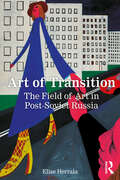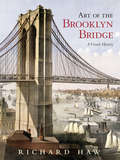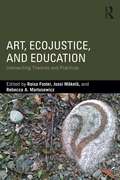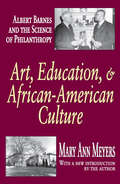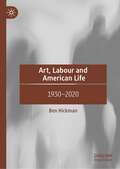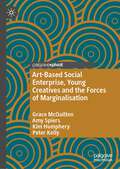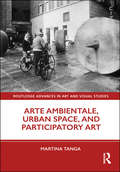- Table View
- List View
Art Therapy and Social Action
by Michael Franklin Pat Allen Frances F. Kaplan Edward Ned Bear Susan Berkowitz Lani Alaine Gerity David GussakArt Therapy and Social Action is an exciting exploration of how professionals can incorporate the techniques and approaches of art therapy in their work to address social problems. Examining the expanding role of art practitioner as social activist, leading art therapists and other professionals show how creative methods can be used effectively to resolve conflicts, manage aggression, heal trauma and build communities. The contributors provide examples of innovative programs on a range of topics, including those designed to address gun crime, homelessness, racism and experiences of terrorism, among others. This timely book provides new techniques and successful models for art therapists, counselors and mental health practitioners working directly with the challenges of modern society.
Art Therapy and Social Action: Treating the World's Wounds
by Maxine Borowsky Junge Pat Allen Edward Ned Bear Susan Berkowitz Frances KaplanArt Therapy and Social Action is an exciting exploration of how professionals can incorporate the techniques and approaches of art therapy in their work to address social problems. Examining the expanding role of art practitioner as social activist, leading art therapists and other professionals show how creative methods can be used effectively to resolve conflicts, manage aggression, heal trauma and build communities. The contributors provide examples of innovative programs on a range of topics, including those designed to address gun crime, homelessness, racism and experiences of terrorism, among others. This timely book provides new techniques and successful models for art therapists, counselors and mental health practitioners working directly with the challenges of modern society.
Art Therapy for Social Justice: Radical Intersections
by Savneet K. TalwarArt Therapy for Social Justice seeks to open a conversation about the cultural turn in art therapy to explore the critical intersection of social change and social justice. By moving the practice of art therapy beyond standard individualized treatment models, the authors promote scholarship and dialogue that opens boundaries; they envision cross disciplinary approaches with a focus on intersectionality through the lens of black feminism, womanism, antiracism, queer theory, disability studies, and cultural theory. In particular, specific programs are highlighted that re-conceptualize art therapy practice away from a focus on pathology towards "models of caring" based on concepts of self-care, radical caring, hospitality, and restorative practice methodologies. Each chapter takes a unique perspective on the concept of "care" that is invested in wellbeing. The authors push the boundaries of what constitutes art in art therapy, re-conceptualizing notions of care and wellbeing as an ongoing process, emphasizing the importance of self-reflexivity, and reconsidering the power of language and art in trauma narratives.
Art World City: The Creative Economy of Artists and Urban Life in Dakar (African Expressive Cultures)
by Joanna Grabski“Insightful . . . should be on the bookshelf of anyone interested in contemporary art on the continent of Africa, its politics, its display, its economics.” —African ArtsArt World City focuses on contemporary art and artists in the city of Dakar, a famously thriving art metropolis in the West African nation of Senegal. Joanna Grabski illuminates how artists earn their livelihoods from the city’s resources, possibilities, and connections. She examines how and why they produce and exhibit their work and how they make an art scene and transact with art world mediators such as curators, journalists, critics, art lovers, and collectors from near and far. Grabski shows that Dakar-based artists participate in a platform that has a global reach. They extend Dakar’s creative economy and the city’s urban vibe into an “art world city.”“In her fine-grained analysis, Joanna Grabski demonstrates the ways that the urban environment and the sites of art production, exhibition, and sale imbricate one another to constitute Dakar as an Art World City.” —Mary Jo Arnoldi, Curator, Anthropology, National Museum of Natural History, Smithsonian“A valuable addition to the anthropology of cities and of art worlds. It stretches and revises the notion of art world to include multiple scales, and illustrates how the city enables simultaneous engagement for artists with local, national, Pan-African, and global discourses and platforms.” —City & Society“A beautiful book. The photographs, most of which are by the author, are stunning.” —College Art Association Reviews
Art Worlding: Planning Relations (Visual Modernities)
by Julie CrawshawTracing the associations between artists, planners and engineers with and within the materials of our environment, this book introduces the more than human relational theory of ‘art worlding’ as a way of coming to know our relational continuity. Through a series of ‘sculptural’ ethnographies of the making and doing of art in urban and rural contexts, the author re-orientates the art-planning relationship in recognition of art practice as a way of knowing more than human relations, thus promoting the organic continuity between humans and environment. Methodologically innovative, the book traces the inter-relation of art as part of planning practice and integrates artistic practice as a mode of inquiry within planning research. It introduces a new paradigm for public art scholarship and practice that re-connects art and planning. Art Worlding: Planning Relations will appeal to sociologists and social anthropologists with interests in art practice, as well as those working in the fields of urban and rural planning, urban regeneration and cultural management.
Art Worlds
by Howard S. BeckerThis classic sociological examination of art as collective action explores the cooperative network of suppliers, performers, dealers, critics, and consumers who - along with the artist - "produce" a work of art. Howard S. Becker looks at the conventions essential to this operation and, prospectively, at the extent to which art is shaped by this collective activity. The book is thoroughly illustrated and updated with a new dialogue between Becker and eminent French sociologist Alain Pessin about the extended social system in which art is created, and with a new preface in which the author talks about his own process in creating this influential work.
Art Worlds, 25th Anniversary Edition: 25th Anniversary edition, Updated and Expanded
by Howard S. BeckerThis classic sociological examination of art as collective action explores the cooperative network of suppliers, performers, dealers, critics, and consumers who—along with the artist—"produce" a work of art. Howard S. Becker looks at the conventions essential to this operation and, prospectively, at the extent to which art is shaped by this collective activity. The book is thoroughly illustrated and updated with a new dialogue between Becker and eminent French sociologist Alain Pessin about the extended social system in which art is created, and with a new preface in which the author talks about his own process in creating this influential work.
Art and Creativity in Reggio Emilia: Exploring the Role and Potential of Ateliers in Early Childhood Education (Contesting Early Childhood)
by Vea VecchiThis book explores the contribution of and art and creativity to early education, and examines the role of the atelier (an arts workshop in a school) and atelierista (an educator with an arts background) in the pioneering pre-schools of Reggio Emilia. It does so through the unique experience of Vea Vecchi, one of the first atelieristas to be appointed in Reggio Emilia in 1970. Part memoir, part conversation and part reflection, the book provides a unique insider perspective on the pedagogical work of this extraordinary local project, which continues to be a source of inspiration to early childhood practitioners and policy makers worldwide. Vea’s writing, full of beautiful examples, draws the reader in as she explains the history of the atelier and the evolving role of the atelierista. Key themes of the book include: • processes of learning and knowledge construction • the theory of the hundred languages of childhood and the role of poetic languages • the importance of organisation, ways of working and tools, in particular pedagogical documentation • the vital contribution of the physical environment • the relationship between the atelier, the atelierista, the school and its teachers This enlightening book is essential reading for students, practitioners, policy makers and researchers in early childhood education, and also for all those in other fields of education interested in the relationship between the arts and learning.
Art and Culture in the Multiverse of Metaverses: Immersion, Presence, and Interactivity in the Digital Age (Springer Series on Cultural Computing)
by James HutsonDrawing on the art historical framing of Location, Place, and Identity, this book will examine how the factors of Immersion, Presence, and Interactivity of XR are shaping our understanding of the world and our place within it. Location refers to the specific geographical or spatial context in which a work of art is created or experienced. Place refers to the social, cultural, and historical context of that location. Identity refers to the ways in which individuals and communities construct and express their sense of self and belonging within those contexts. Through case studies and theoretical analysis, Art and Culture in the Multiverse of Metaverses - Immersion, Presence, and Interactivity in the Digital Age, will explore how the factors of Immersion, Presence, and Interactivity of XR can be aligned with these art historical concepts, providing new opportunities for understanding and engaging with Location, Place, and Identity. For example, XR can be used to create immersive experiences of historical locations and cultural sites, allowing users to explore and engage with them in ways that would otherwise be impossible. Additionally, XR can be used to create interactive artworks that engage with issues of identity and belonging, creating new possibilities for self-expression and exploration.
Art and Enchantment: How Wonder Works (Contemporary Liminality)
by Patrick CurryThis book concerns the experience of enchantment in art. Considering the essential characteristics, dynamics and conditions of the experience of enchantment in relation to art, including liminality, it offers studies of different kinds of artistic experience and activity, including painting, music, fiction and poetry, before exploring the possibility of a life oriented to enchantment as the activity of art itself. With attention to the complex relationship between wonder in art and the programmatic disenchantment to which it is often subject, the author draws on the thought of a diverse range of philosophers, sociological theorists and artists, to offer an understanding of art through the idea of enchantment, and enchantment through art. An accessible study, richly illustrated with experience – both that of the author and others – Art and Enchantment will appeal to scholars and students of sociology, anthropology, philosophy, and anyone with interests in the nature of aesthetic experience.
Art and Memorialisation: Truth-Telling Through Creative Practice in Settler Colonial Australia (Indigenous-Settler Relations in Australia and the World #6)
by Amy Spiers Genevieve GrievesThis edited volume reflects on the profound effort undertaken by artists to contest settler denial and amnesia to disclose Australia's foundations in racialised violence and land theft. The book examines how First Nations creative and cultural practitioners have turned to the unique spaces of art and culture to remember and mourn the profound loss of life caused by British invasion and colonisation in the absence of official commemoration and public acknowledgement of the damage caused. It significantly focuses on a number of creative practitioners driving this powerful memory-work, containing contributions from some of the leading thinkers on truth-telling through creative practice, including Fiona Foley, Dianne Jones, Vicki Couzens, Julie Gough, r e a, Tony Birch, Paola Balla, Neika Lehman, Arlie Alizzi, Charmaine Papertalk Green, Kate Golding, Odette Kelada and Clare Land. An important contribution to scholarship on the public memorialisation of difficult histories, this significant edited collection foregrounds First Nations, female, queer, trans and gender diverse artists and scholars from the continent that is known as 'Australia'. Taken together these deeply researched, considered texts, poems and conversations lend vital, critical perspectives on the ways artists are confronting settler colonial Australia’s toxic colonial memorial culture of denial. This book recognises that through a range of creative means and mediums, artists and cultural practitioners are making essential contributions to truth-telling, devising evocative, sensitive ways to make the injustices committed against First Peoples not only visible and tangible, but also strongly felt and grieved.
Art and Soul: Rudolf Steiner, Interdisciplinary Art and Education (Landscapes: the Arts, Aesthetics, and Education #25)
by Victoria De RijkeThis book brings together Steiner's philosophical, biodynamic and cultural contributions to education, where 'spirit' and ‘soul’ are the creative elements in human evolution. His thought is applied to selected examples of innovative artistic practice and pedagogy of the present. This volume is intended for researchers in the arts and education with an interest in Rudolf Steiner's huge influence on educational thought and policy.This is an urgent point in time to reflect on the role of arts in education and what it might mean for our souls. An accessible yet scholarly study of interdisciplinarity, imagination and creativity is of critical widespread interest now, when arts education in many countries is threatened with near-extinction.
Art in Action
by Stephen K. Levine Ellen G. LevineThe field of expressive arts is closely tied to the work of therapeutic change. As well as being beneficial for the individual or small group, expressive arts therapy has the potential for a much wider impact, to inspire social action and bring about social change. The book's contributors explore the transformative power of the arts therapies in areas stricken by conflict, political unrest, poverty or natural disaster and discuss how and why expressive arts works. They look at the ways it can be used to engage community consciousness and improve social conditions whilst taking into account the issues that arise within different contexts and populations. Leading expressive arts therapy practitioners give inspiring accounts of their work, from using poetry as a tool in trauma intervention with Iraqi survivors of war and torture, to setting up storytelling workshops to aid the integration of Ethiopian Jewish immigrants in Israel. Offering visionary perspectives on the role of the arts in inspiring change at the community or social level, this is essential reading for students and practitioners of creative and expressive arts therapies, as well as psychotherapists, counsellors, artists and others working to effect social change.
Art of Judging: Volume 8
by James. E BondThe single most important issue in American constitutional law is the role the Supreme Court should play in interpretation of the constitution. This issue has been a source of controversy since at least 1803, when Chief Justice John Marshall proclaimed that the Supreme Court could declare acts of Congress unconstitutional. But public attention has been refocused by the recent debate between Attorney General Edwin Meese and Supreme Court Justice William Brennan. The Attorney General admonished the Justices to confine themselves to strict construction of the Constitution-to apply the Constitution as the framers intended. Justice Brennan rejected this as errant and arrogant because the framers had certainly not thought about the specific problems facing the country today.
Art of Memories: Curating at the Hermitage
by Vincent Antonin LépinayOnce the home of Catherine the Great’s private art collection, Russia’s State Hermitage Museum became the largest museum in the Soviet Union and, since the collapse of the USSR, one of the most active museums in the world. The Hermitage is a global model for the collection and preservation of fine art, deeply shaped by its need to protect itself and its holdings from the world beyond its gates. <P><P>In Art of Memories, Vincent Antonin Lépinay documents the Hermitage’s curatorial practices in an innovative consideration of the museum as a cultural laboratory.Lépinay analyzes the tensions between the museum as a space of exploration of the collections and as a culture heavily invested in self-protection from the outside world. During a time when traveling abroad was rare, a generation of art historians produced a culture of confined scholarship premised on their proximity to the holdings of a museum enclave. As the Hermitage has become increasingly present on the world museum scene, its culture of secrecy and orality has endured. Lépinay analyzes the ethos of Hermitage curators and scholars over the transition from Soviet to post-Soviet museum cultures, considering the mobility of art, documentation of the collection, and the transformation of expertise. Based on Lépinay’s extraordinary access to the Hermitage and the scholars who work there, Art of Memories opens the door of one of the world’s great museums to reveal how art history is made. It is an essential study for readers interested in the role that outside forces play in culture, organizations, and the production of knowledge.
Art of Transition: The Field of Art in Post-Soviet Russia
by Elise HerralaThe dissolution of the Soviet Union brought a massive change in every domain of life, particularly in the cultural sector, where artists were suddenly "free" from party-mandated modes of representation and now could promote and sell their work globally. But in Russia, the encounter with Western art markets was fraught. The Russian field of art still remains on the periphery of the international art world, struggling for legitimacy in the eyes of foreign experts and collectors. This book examines the challenges Russian art world actors faced in building a field of art in a society undergoing rapid and significant economic, political, and social transformation and traces those challenges into the twenty-first century. Drawing on historical and ethnographic research, Art of Transition traces the ways the field of art has developed, evolved, and been sustained in Russia after socialism. It shows how Russia’s art world has grappled with its Soviet past and negotiated its standing in an unequal, globalized present. By attending to the historical legacy of Russian art throughout the twentieth century, this book constructs a genealogy of the contemporary field of postsocialist art that illuminates how Russians have come to understand themselves and their place in the world.
Art of the Brooklyn Bridge: A Visual History
by Richard HawThe Brooklyn Bridge is a pre-eminent global icon. It is the world’s most famous and beloved bridge, a "must-see" tourist hotspot, and a vital fact of New York life. For almost a hundred and forty years it has inspired artists of all descriptions, fueling a constant stream of paintings, photographs, lithographs, etchings, advertising copy, movies, and book, magazine, and LP covers. In consequence, the bridge may have the richest visual history of any man-made object, so much so, in fact, that almost no major American artist has failed to pay homage to the span in some form or other. Oddly, however, there are no books currently available that chart and discuss the bridge’s visual history or its role in the development of American (or Western) art. This monograph aims to correct that, providing a full visual record of the bridge from the origins of its conception to the present day. It is a celebration of the bridge’s glorious visual heritage timed to appear when the city will celebrate the span’s 125th birthday.
Art, Anthropology and the Gift (Criminal Practice Ser.)
by Roger SansiIn recent decades, the dialogue between art and anthropology has been both intense and controversial. Art, Anthropology and the Gift provides a much-needed and comprehensive overview of this dialogue, whilst also exploring the reciprocal nature of the two subjects through practice, theory and politics. Fully engaging with anthropology and art theory, this book innovatively argues that art and anthropology don’t just share methodologies, but also deeper intellectual, theoretical and even political concerns, inviting scholars and students alike to look at this contentious relationship in a more critical light. One of the central arguments of the book is that the problem of the ‘gift’ has been central to both anthropological and artistic practice. This very idea connects the different chapters on topics including aesthetics, politics, participation and fieldwork.
Art, Critical Pedagogy and Capitalism (Visual Modernities)
by Paul Alexander StewartThis book offers a re-examination of art production in terms that understand the process of learning as the production of art itself. Drawing on the thought of Ranciere, Freire, Gramsci and Mouffe, it provides an account of the politics of art production and a theoretical understanding of hegemonic power, while developing a view of method in critical pedagogy founded on the process of ‘making adversaries’. Through a re-evaluation of the relationships between process, arts production and pedagogy within accelerated developments of neoliberalism, the author uncovers ways of forming a more co-operative and less conflictual approach to democratic politics. An investigation of ways in which art practice can be used to engage with critical pedagogy in relation to a commodity driven neoliberal agenda, Art, Critical Pedagogy and Capitalism constitutes a radical rethinking of art making, and an attempt to address the paradox between the proliferation of the commodity of learning and the perceived crisis of arts education. As such, it will appeal to scholars of education, pedagogy and the arts with interests in social and critical theory.
Art, EcoJustice, and Education: Intersecting Theories and Practices
by Rebecca A. Martusewicz Raisa Foster Jussi MäkeläEmphasizing the importance of contemporary art forms in EcoJustice Education, this book examines the interconnections between social justice and ecological well-being, and the role of art to enact change in destructive systems. Artists, educators, and scholars in diverse disciplines from around the world explore the power of art to disrupt ways of thinking that are taken for granted and dominate modern discourses, including approaches to education. The EcoJustice framework presented in this book identifies three strands—cultural ecological analysis, revitalizing the commons, and enacting imagination—that help students to recognize the value in diverse ways of knowing and being, reflect on their own assumptions, and develop their critical analytic powers in relation to important problems. This distinctive collection offers educators a mix of practical resources and inspiration to expand their pedagogical practices. A Companion Website includes interactive artworks, supplemental resources, and guiding questions for students and instructors.
Art, Education, and African-American Culture: Albert Barnes and the Science of Philanthropy
by Mary Ann MeyersA physician who applied his knowledge of chemistry to the manufacture of a widely used antiseptic, Albert Barnes is best remembered as one of the great American art collectors. The Barnes Foundation, which houses his treasures, is a fabled repository of Impressionist, post-Impressionist, and early modern paintings. Less well known is the fact that Barnes attributed his passion for collecting art to his youthful experience of African-American culture, especially music. Art, Education, and African-American Culture is both a biography of an iconoclastic and innovative figure and a study of the often-conflicted efforts of an emergent liberalism to seek out and showcase African American contributions to the American aesthetic tradition.Mary Ann Meyers examines Barnes's background and career and the development and evolution of his enthusiasm for collecting pictures and sculpture. She shows how Barnes's commitment to breaking down invidious distinctions and his use of the uniquely arranged works in his collection as textbooks for his school, created a milieu where masterpieces of European and American late-nineteenth and early-twentieth century painting, along with rare and beautiful African art objects, became a backdrop for endless feuding. A gallery requiring renovation, a trust prohibiting the loan or sale of a single picture, and the efforts of Lincoln University, known as the "black Princeton," to balance conflicting needs and obligations all conspired to create a legacy of legal entanglement and disputes that remain in contention.This volume is neither an idealized account of a quixotic do-gooder nor is it a critique of a crank. While fully documenting Barnes's notorious eccentricities along with the clashing interests of the main personalities associated with his Foundation, Meyers eschews moral posturing in favor of a rich mosaic of peoples and institutions that illustrate many of the larger themes of American culture in general and African-American culture in particular.
Art, Excess, and Education: Historical and Discursive Contexts (Palgrave Studies in Educational Futures)
by Kevin Tavin Mira Kallio-Tavin Max RyynänenThis book concentrates on the deep historical, political, and institutional relationships between art, education, and excess. Going beyond field specific discourses of art history, art criticism, philosophy, and aesthetics, it explores how the concept of excess has been important and enduring from antiquity through contemporary art, and from early film through the newer interactive media. Examples considered throughout the book focus on disgust, grandiosity, sex, violence, horror, disfigurement, endurance, shock, abundance, and emptiness, and frames them all within an educational context. Together they provide theories and classificatory systems, historical and political interpretations of art and excess, examples of popular culture, and suggestions for the future of educational practice.
Art, Labour and American Life: 1930–2020
by Ben HickmanThis book examines labour in the age of US hegemony through the art that has grappled with it; and, vice versa, developments in American culture as they have been shaped by work’s transformations over the last century. Describing the complex relations between cultural forms and the work practices, Art, Labour and American Life explores everything from Fordism to feminization, from whitecollar ascendency to zero hours precarity, as these things have manifested in painting, performance art, poetry, fiction, philosophy and music. Labour, all but invisible in cultural histories of the period, despite the fact most Americans have spent most of their lives doing it, here receives an urgent re-emphasis, as we witness work’s radical redefinition across the world.
Art-Based Social Enterprise, Young Creatives and the Forces of Marginalisation
by Peter Kelly Kim Humphery Grace McQuilten Amy SpiersThis book analyses the challenges and opportunities faced by art-based social enterprises (ASEs) engaging young creatives in education and training and supporting their pathways to the creative industries. In doing so, it addresses the complex intersecting issues of marginality and entrepreneurship, particularly in relation to young creatives from socially, economically and culturally diverse backgrounds. Drawing on extensive fieldwork and interviews with twelve key organisations, and three in-depth case studies in Australia, the book offers a detailed analysis of using enterprise to engage with the structural challenges of marginality. The book explores the local and global contexts through which art-based social enterprises (ASEs) operate and within which they attempt – often successfully – to improve access to education and work for emerging creatives. It also attends to the findings generated through engaging with the lived experiences of the staff and young creatives involved in our ASE case studies, in order to understand both the challenges and impacts of the ASE model on young people’s education, training, and employment pathways. The book focuses on three broad themes; precarious youth and digital futures, material practice and sustainable economies, and cultural citizenship in the urban fringe. In exploring these themes, the book contributes to debates about the limits, possibilities and challenges that attach to, and emerge from, an ASE model and highlights the ways in which these models can contribute to young people’s well-being, engagement, education and training, and work pathways. More broadly, it examines the possibilities of art as a means of social and cultural engagement. In the context of the precarious future of the creative industries, this book emphasise the ways in which young artists are building alternative economic and cultural models that support both individual pathways and collective change. This book will move the field forward with a critical lens that engages closely with experience and the lived realities of juggling multiple priorities of social, economic and artistic goals.
Arte Ambientale, Urban Space, and Participatory Art (Routledge Advances in Art and Visual Studies)
by Martina TangaWorking in 1970s Italy, a group of artists—namely Ugo La Pietra, Maurizio Nannucci, Francesco Somaini, Mauro Staccioli, Franco Summa, and Franco Vaccari—sought new spaces to create and exhibit art. Looking beyond the gallery, they generated sculptural, conceptual, and participatory interventions, called Arte Ambientale (Environmental Art), situated in the city streets. Their experiments emerged at a time of cultural crisis, when fierce domestic terrorism aggravated an already fragile political situation. To confront the malaise, these artists embraced a position of artistic autonomy and social critique, democratically connecting the city's inhabitants through direct art practices.
